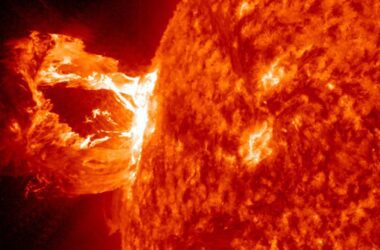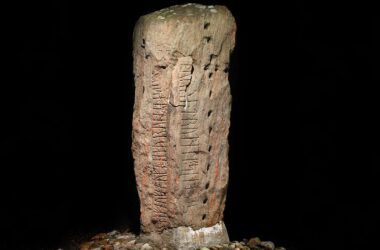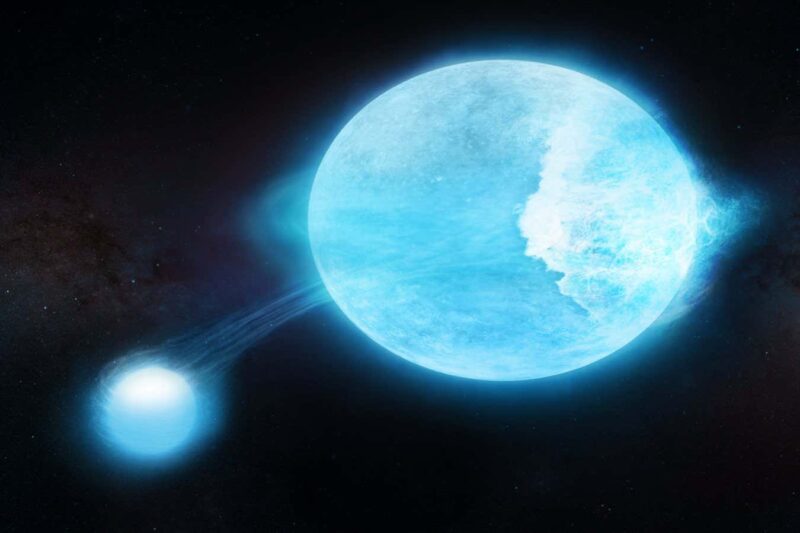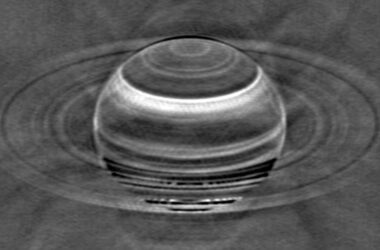Artist’s depiction of binary star system MACHO 80.7443.1718, with huge waves rising on the larger star
Melissa Weiss/Center for Astrophysics/Harvard & Smithsonian
A massive star, lightyears away, is being pummelling by waves taller than the skyscrapers of Earth.
This star orbits another in an extremely elliptical pattern. Like the moon’s influence on Earth’s tides, the gravitational attraction of two nearby stars causes tidal waves when they swing close to one another. This causes the stars to appear temporarily brighter as they extend and bulge out at the equator.
“The brightness varies in a way that is similar to a heartbeat,” explains Avi Loeb of the Harvard-Smithsonian Centre for Astrophysics in Cambridge, Massachusetts.
Now Loeb and his Centre for Astrophysics colleague Morgan MacLeod have discovered the most intense “heartbeat star” ever observed.
The binary star system MACHO 80.7443.1718 was discovered in the 1990s and is located in the Large Magellanic Cloud, which is roughly 160,000 light-years from Earth. The central star is 34.5 times as massive as the Sun and 24 times as wide.
Astronomers quickly determined that it was a star with a heartbeat after its discovery. However, more recent studies have shown that its brightness variations are significantly larger than typical pulses. According to Loeb, for average heartbeat stars, the brightness difference across an orbit would be less than 1%. There is 20% variation in this star.
In their computer simulations, Loeb and MacLeod determined that the larger star’s tidal waves rise to a height three times that of our sun before crashing back into the star’s surface, much like waves do on Earth’s oceans when they reach the shore.
MacLeod says, “It’s wonderful that we can understand what’s going on out there in the universe by observing the nature around us. “Maybe the next time you see a wave crash on the beach, you’ll think of this star,” he said.
“This particular binary happened to be such that there is a companion coming from a large distance and getting really close,” adds Loeb, explaining the drastic variations in brightness.
FAQs
- What is a “heartbeat star”?
- A “heartbeat star” refers to a binary star system where the gravitational attraction of two stars causes tidal waves, leading to periodic changes in their brightness.
- How do tidal waves affect the star’s brightness?
- Tidal waves rise on the star’s surface due to the gravitational interaction of the binary stars, causing temporary bulging and brightness variations.
- What is MACHO 80.7443.1718?
- MACHO 80.7443.1718 is a binary star system located in the Large Magellanic Cloud, 160,000 light-years from Earth. Its central star is significantly larger than the Sun.
- Why is MACHO 80.7443.1718 unique?
- While all heartbeat stars experience brightness variations, this star’s variations are much larger than typical pulses, with a 20% difference in brightness across its orbit.
- How do scientists explain the brightness variations?
- Computer simulations suggest that tidal waves on the larger star rise to three times the size of the Sun before crashing back onto its surface, leading to the observed brightness changes.







